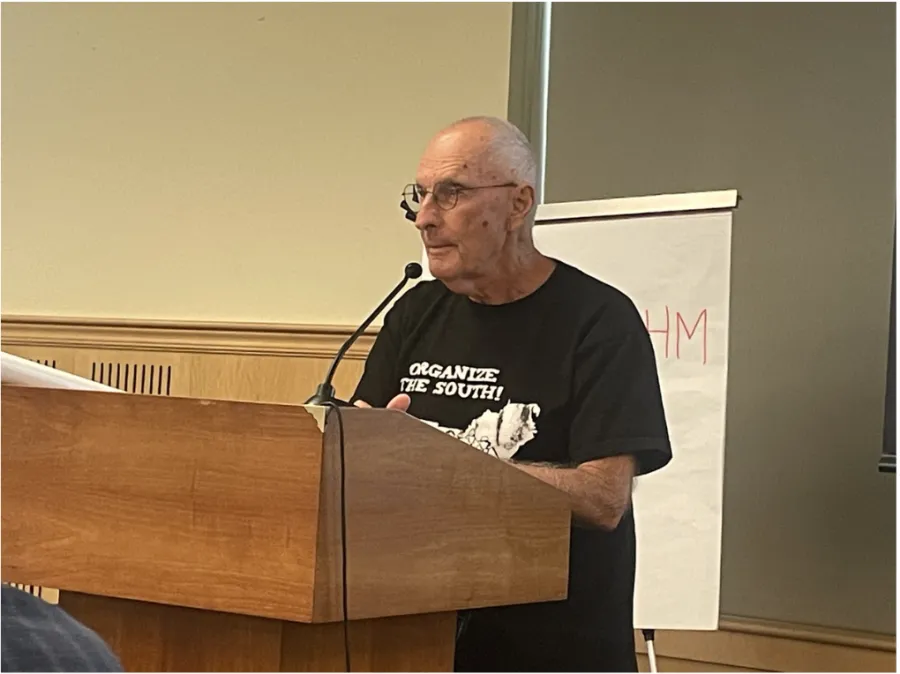Veteran Union Organizer Ed Bruno Discusses Organizing Strategies to Rebuild the Labor Movement

One of the highlights of Summer Institute was a presentation by legendary union organizer Ed Bruno titled “Taking this Back to Your Union: Strategies to Get Organized.” Bruno, who formerly served as the director of the United Electrical Radio and Machine Workers of America (UE) and Organizing Director for the National Nurses Union, discussed how to win broad class-based fights and rebuild the labor movement using examples from the 1930s and more recent victories of nurses in the U.S. South.
As Bruno noted, union density is at the lowest level since 1920 after decades of a decline in union membership. Maine’s private sector union density is 6 percent, only about 7 tenths of a percent higher than Mississippi.
“And I'll be the first one to apologize,” said Bruno. “I've been a union organizer for 50 years. In my period of time, we have driven the union density level down to historic lows.” He jokingly added, “I’m sorry. I'll take my share.”
Our challenge, he said, is to lay the groundwork to once again have “breakthroughs” like in the 1930s when millions of workers joined unions or in 1970 when public sector workers carried out a series of "illegal" strikes to win collective bargaining rights. In the first three months of 1970, he noted, there was a public sector strike somewhere in the country every 36 hours.
“We can't make up for this drift with a hundred [union members] at a time or even a thousand at a time,” said Bruno.
He pointed out that it took years of organizing and trying different strategies, which mostly failed, to get to the kind of breakthroughs of the 1930s and 1970s. For instance, in every major auto plant, packing house, steel mill and aluminum factory in the nation there were cadres of small groups of very committed workers who agitated and organized for years.
“They were not in isolation, they were tied together in networks so they could compare notes, they could talk over strategy, they got to know one another,” Bruno noted. “So the guy in the axle plant got to know the woman in the assembly plant.”
As a result of these connections, unions like the United Autoworkers, UE and United Steelworkers grew across large sectors of the economy.
“This was a period of years of experimentation, of trying to figure out what works and what doesn’t,” said Bruno “Almost everything didn't work. That's usually the pattern here. Nothing works until the one thing does. Then all of a sudden millions of people join the union.”
Bruno drew on his experience working on the National Nurses Organizing Committee’s (NNOC) campaign to organize registered nurses in the South. First, the committee mapped out the industry, looked at where facilities were concentrated and figured out strategic hospitals to organize in order to move the industry. For instance, the nurses organized groups of nurses in San Antonio, El Paso, Houston and Corpus Christi and tied them together to form NNOC Texas, followed by statewide organizing committees in other southern states. A key organizing strategy was to find an issue that nurses could coalesce around. Nothing got them more riled up than patient safety and ratios. Safe patient staffing became a rallying cry for the nurses. They began organizing around the issue and fought for legislation to create safe nurse staffing ratios in hospitals
“It was an important issue, but it was also a mechanism for getting nurses in motion, getting them to understand the value of collective action and the practice of solidarity,” said Bruno. “It was laying the infrastructure for the possibilities of collective bargaining.”
Eventually the two major health care corporations in the South agreed to meet with the nurses, which led to a breakthrough. After seven years, they won collective bargaining agreements in Texas, Kansas, Missouri, Arizona, New Orleans, Louisiana, North Carolina and Florida where the unions didn’t exist before. Bruno pointed out that winning the union election is merely the “ticket to the dance,” so it is critical to develop an effective organizing strategy to win a first contract. He said a key strategy is to plan National Labor Relations Board elections within a compressed period of time. In NNOC’s case, they swept fifteen elections, resulting in fifteen bargaining tables in action.
“That allowed us to coordinate the bargaining and magnify our power, so we're not just at one hospital and one bargaining table. We’re at fifteen at a time,” said Bruno. “Nowadays, that's now up to about 30 or so.”
He said such a campaign requires resources, commitment and willpower by unions. Bruno pointed out that nearly 95 percent of Maine private sector workers and 88% of all workers do not have a union, so a broader class-based campaign like they did in the South should also be deployed here. As far as galvanizing workplace issues, he suggested that heat is something most workers can agree is a problem, whether it’s working in freezing temperatures or extreme heat as we’ve had recently in Maine.
Another major issue for Mainers is retirement security because so few workers nowadays have access to defined benefit pension plans in our aging state. In the 1970s, the majority of major corporations provided defined benefit pensions, but after the federal laws began to favor 401k-type plans in the early 80s, the majority of companies began ditching traditional pensions. Bruno said a movement for “pensions for all” could be an issue that mobilizes workers because it is something that could be collectively bargained and it has a potential legislative solution.
“Raise the cap on Social Security. Social Security will be liquid for the next hundred years,” Bruno said, drawing loud applause. “It's as simple as that.”
Bruno said a broad class-based organizing campaign will require not only home visits, but also going into workplaces and forming core cadres like the nurses and autoworkers.
“You go to a workplace of a thousand people, you need ten or fifteen people to constitute a cadre,” he said. “None of these are ever big. The Flint sit-down strike was planned by seven men. The numbers come later. The law tells us you got to have the majority first and then you get a union. That's not true. You got to have a campaign and collective action first and then you'll get the numbers later on.”
Bruno closed by telling the audience of union members that it is a “blessing” to take part in major organizing campaigns that have resulted in significant improvements to people’s lives. He compared building a union to the story of workers who brought their children to New York to see the Empire State Building and tell them, “I helped build that.”
“That's part of having a fulfilling life,” said Bruno. “It makes your life worthwhile. It's good for you to participate in these kinds of things. And you can have a life in addition. You don't have to sacrifice anything.”
